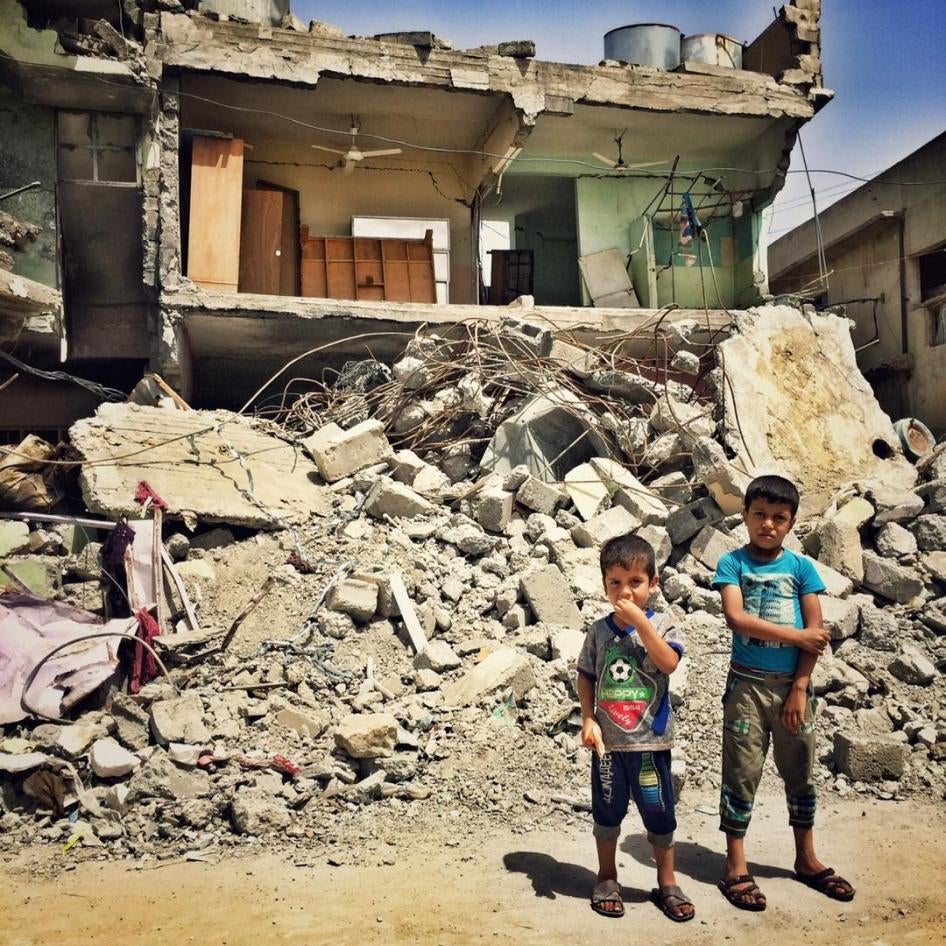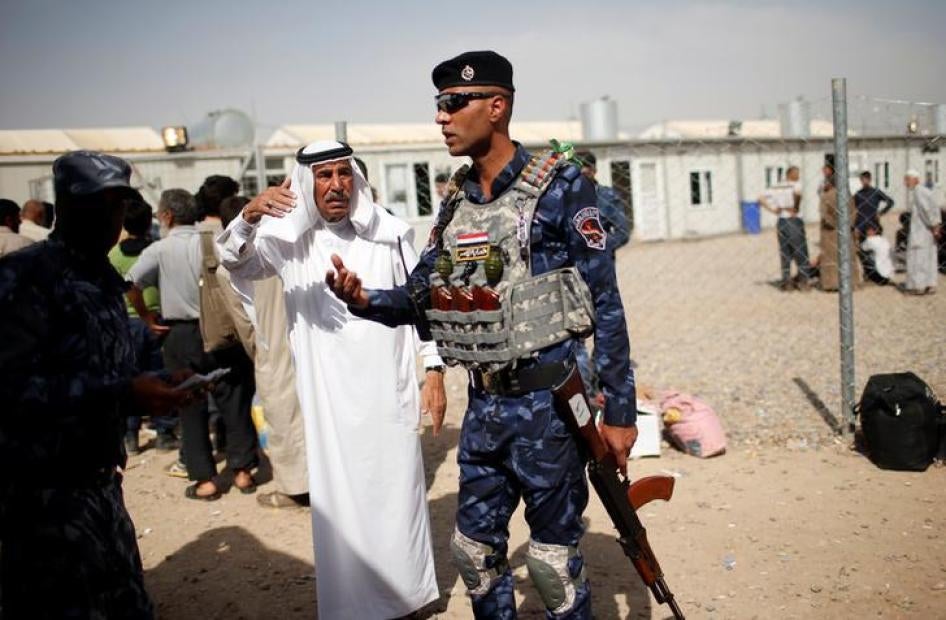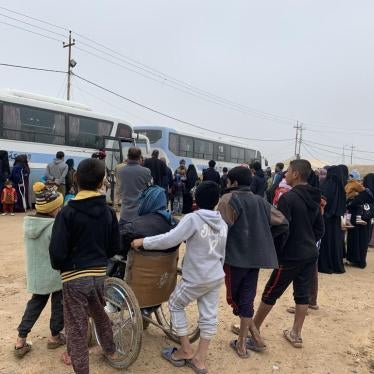(Beirut) – The Iraqi army and other local security forces have forced over 300 displaced families to return to west Mosul neighborhoods still under risk of attack by the Islamic State (also known as ISIS), Human Rights Watch said today. The families, who had fled to the Hammam al-Alil and Hajj Ali camps for displaced people, are severely short of water, food, electricity, and medical assistance.
Displaced residents, camp staff in Hammam al-Alil, and three federal police officers said that families were returned to certain west Mosul neighborhoods to make room for newly displaced people from more recently retaken neighborhoods of west Mosul. But aid workers involved in camp management and United Nations assessments of camp capacity indicated that the camps still have space for new arrivals.
“People from western Mosul fled some of the worst fighting there and finally found safety, only to be forced back to areas still under ISIS fire,” said Lama Fakih, deputy Middle East director at Human Rights Watch. “These families should not be forcibly returned to unsafe areas and areas that lack adequate water, food, electricity, or health facilities.”
The UN Guiding Principles on internal displacement state that all internally displaced people should be able to choose where they live and have the right to be protected against forcible return to any place where their life, safety, liberty, or health would be at risk.
Human Rights Watch visited the Mansour and Wadi Hajjar neighborhoods of west Mosul on May 15, 2017, and spoke with some of the families. Three people from Wadi Hajjar said they had fled the fighting there for camps in Hammam al-Alil, 30 kilometers south of west Mosul, between one and two months ago. They said that at around 1 p.m. on May 9, camp staff came to their tents and said they had to leave because the camp was full, and new arrivals were on the way from other west Mosul neighborhoods that had more recently been retaken. Some families were given up to two hours to leave, while others were ordered to leave immediately, without being able to gather their belongings.
The west Mosul residents who were forcibly returned and spoke to Human Rights Watch said they had not wanted to return because of the lack of adequate food, water, and health facilities.
A staff member at the same camp in Hammam al-Alil said that an army commander called the camp manager on May 9, and said the camp had two hours to round up all the families from Wadi Hajjar, Tal Rumman, and Mansour neighborhoods. The staff started going tent by tent in Section A to deliver the instructions.
“The families were not ready, and most did not want to go,” the staff member said. “In the end, it was totally indiscriminate who got to stay because we had not made it to their tent in time, and who was forced to leave. We only got through a small number of the tents when at least 30 army trucks came and took at least 300 families.”
One man said Iraqi army officers loaded him into a truck with three families and drove them to Baghdad Circle, the southern entry point to the city, just over two kilometers from the front line, without giving them any choice in where they were taken.
The families walked back to their neighborhoods or shared taxis. One woman from Wadi Hajjar who could not afford a taxi said she walked back with her four young children, the youngest 3 months old. Her home was destroyed during the fighting and her husband was executed by ISIS, she said. “I have no water and cannot find milk here for my baby,” she said. She was living in an abandoned apartment in the area and was afraid her baby would die because she couldn’t get milk.
On May 10, the camp staff member said, staff rounded up more families, but stopped when they got word that the mayor of the town of Hammam al-Alil had ordered the returns halted.
An international staff member said that the mayor issued an order on May 9, after hearing about the forcible returns, and that some of the families who had been forced out heard about it from friends or relatives in the camp and returned to the camp. But the staff member was concerned that their ration cards might not have been returned to them. The mayor told Human Rights Watch all the returns had been voluntary, and that only 67 families had ultimately remained in west Mosul.
However, two people from Wadi Hajjar, who said they had lived in the same camp, said that at about 7 a.m. on May 14, camp management came to their tent and told them they had two hours to get ready to leave. They both protested but were told they had no choice. They said the army loaded up about 30 families from Wadi Hajjar, Mansour, and Wadi al-Ayn onto several trucks and drove them to Baghdad Circle. One said he returned to his home in Wadi Hajjar to find that an ISIS mortar had blasted through his roof. Neighbors told him it had happened 10 days earlier.
Another man from Wadi Hajjar who had spent a month and a half in a camp in Hajj Ali, a village about 70 kilometers south of Mosul, said that on May 10, a local sheikh arrived at the camp with several guards in two vehicles. When residents gathered around, the sheikh said: “Those of you from liberated neighborhoods have to go back home.” The man said he was concerned about having to go back, but left three days later, sharing a taxi with 10 other people back to Wadi Hajjar.
Dozens of the returned families from Wadi Hajjar and Mansour said that they had limited electricity and water. Many said they could not afford to buy enough food for their families from the local markets, where prices remain elevated.
Abu Omar, the mayor of Wadi Hajjar, said that one hospital in the area has recently reopened, but has yet to offer more than the most basic medical services. An aid worker traveling into west Mosul told Human Rights Watch they only knew of one other clinic in the five neighborhoods that was operational.
People who had returned to Wadi Hajjar said that ISIS mortar attacks had hit the neighborhood as recently as May 5, and that they feared ISIS grenade attacks delivered by drone. Security reports from the International NGO Safety Organisation said that the Mansour neighborhood was hit with an ISIS mortar attack as recently as May 12. The front line is currently between one and three kilometers from the neighborhoods where people returned.
As of May 16, UN data showed that there were at least 7,000 plots in various camps available for new arrivals and two international aid workers told Human Rights Watch that organizations have identified multiple sites for potential new camps. They said that one new camp opened at about the same time as the first forcible returns and that another is to open in late May. They said that at least one camp was ready to receive displaced people but was sitting empty at the order of local authorities.
In addition, at least 38 percent of displaced people were seeking refuge in host communities, not camps, with that number rapidly rising in recent weeks to up to 80 percent of the new arrivals. However, aid workers said, Iraqi authorities have been hesitant to look beyond the camps in their planning to try to meet the needs of people seeking refuge elsewhere.
“The armed forces have an obligation to protect civilians, but they are instead putting civilians in danger by sending them back into unsafe areas,” Fakih said. “All returns should be safe, dignified, voluntary, and informed.”










